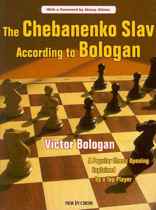Chebanenko Slav According To Bologan, The
Victor Bologan

The Chebanenko Slav According To Bologan is the rare opening book written by an active world-class player. It is entirely devoted to the position reached after 1.d4 d5 2.c4 c6 3.Nc3 Nf6 4.Nf3 a6.
Victor Bologan, whose book of his best games was widely praised, has another winner here. His tribute to his trainer and teacher, Vyacheslav Andreevich Chebanenko (1942-1997) is full of funny and touching anecdotes and gives a good impression of what it was like to learn and analyze with him. There are several nice photos from this time period.
I knew that Chebanenko invented the 4 a6 Slav from the ground up and was closely identified with 1.c4 e5 2.Nc3 Bb4, but didnt realize that he was one of the pioneers in playing an early Bxc6 in the Rossolimo nor that he was the analyst who discovered the thunderbolt 11… d5 played in the first game of the Fischer-Petrosian Candidates Match in 1971. In a case of great minds thinking alike, Chebanenko was the first to play 11… Ne8! (after 1.d4 Nf6 2.c4 g6 3.Nf3 Bg7 4.g3 0-0 5.Bg2 d6 6.0-0 Nbd7 7.Nc3 e5 8.e4 c6 9.h3 Qb6 10.Re1 exd4 11.Nxd4) against Artamov in 1968, though Smyslov, annotating his win over Bukal (Linz 1980) with 11 Ne8 remarks, “It is curious that I prepared this move for my match with Botvinnik (1954) but I was able to employ this analysis only a quarter of a century later.
Bologan examines all of Whites tries: 5.cxd5, 5.h3, 5.Qc2, 5.Qb3, 5.g3, 5.Bf4, 5.Bg5, 5.a4, 5.Ne5, 5.e3 and 5.c5. There is a lot of analysis but also plenty of prose and the conclusions at the end of each chapter pull things together. While I found the work to be of a uniformly high quality, there are a few glitches. In chapter 6 after 5.Bf4 dxc4 6.g3 the comment is made that the Catalan development is possible but not optimal with the Bishop already committed to f4, which makes perfect sense. A variation is then given which follows 6 …b5 7.Bg2 Bb7 8.0-0 e6 9.Ne5 Be7 10.Qc2 (10.a4 is also given as promising) 10… Qxd4 11.Rfd1 Qc5 12.Ne4 Nxe4 13.Bxe4 g6 (Bologan points out 13 …f5? loses to 14.Bxf5 exf5 15.Qxf5 Bf6 16.Rd7!!) 14.Be3 Qxe5 15.Bd4 Qc7 16.Bxh8 Nd7 17.b3 f5 18.Bg2 Kf7 19.Bb2 cxb3 20.axb3 c5 21.e4 with a slight edge to White due to the insecure position of the enemy King according to Bologan. No improvements are given for Black, yet this is not considering a particularly threatening line by theory.
Bologan and English GM Chris Ward (in his chapter Having Fun Against the 4 a6 Slav Dangerous Weapons: The Queens Gambit) butt heads after 1.d4 d5 2.c4 c6 3.Nf3 Nf6 4.Nc3 a6 5.c5 Nbd7 6.Bf4 Nh5 7.Bg5 h6 8.Bd2 when three moves are considered.
(A) 8… g6 9.e4 dxe4 10.Nxe4 Bg7 11.Bc4 Nhf6 Bocharov-Burmakin, Togliatti 203. Bologan continues a few mores moves and writes Black is close to equality. Ward thinks White is better after 12.Nc3 as the Knight on d7 is misplaced. He also believes 12.Nxf6+ Nxf6 13.0-0 and 12.Qb3 0-0 13.Nxf6+ Nxf6 14.0-0 Nd5 15.Rfe1 leave White with a small but lasting advantage.
(B) 8 …Qc7 9.e4 dxe4 10.Nxe4 Ndf6 11.Nxf6+ Nxf6 12. Bc4 (Ward also looks at 12.Ne5) 12 …Bf5 13.0-0 e6, = (Bologan) 14.Qe2 Rd8 15.Bc3 Be7 16.0-0 0-0 17.Rad1 Nd5 19.Rfe1 and Ward likes White.
(C) 8 …Nhf6 9.Bf4 g5 (Bologans main line not examined by Ward who focuses on 9… Nh5 10.Be5) 10.Bg3 Bg7 11.e3 Nh5 12.Be5 f6 13.Nd2 0-0 14.Bg3 Nxg3 15.hxg3 e5 16.Nb3 exd4 17.exd4 f5 18.Be2 f4 19.Qd3 fxg3 20.Qxg3 Qf6 21.0-0 Qxf4 22.Qxf4 Rxf4 23.Rad1. In this endgame, Blacks chances are not worse (Avrukh-Volkov, Internet 2004) Bologan.
The Chebanenko Slav According To Bologan is not a complete guide to all a6 treatments, unlike Glenn Flears 2003 book on the subject for Everyman, as Bologan doesnt believe in the a6 Slav against every White move order. For instance after 1.d4 d5 2.c4 c6 3.Nf3 Nf6 4.e3 he recommends 4 Bf5. Against 3.Nc3 Nf6 4.e3 he thinks 4… a6 is fine. That White should transpose back to normal lines with 5.e3 and if 5.Qc2 then … e6 and … c5 exploits the premature development of the Queen.
34 exercises and player and opening indexes round out this well produced book, which like other New in Chess publications is very nicely produced with a clean layout and lots of diagrams.
Highly recommended for those who play the …a6 Slav.
